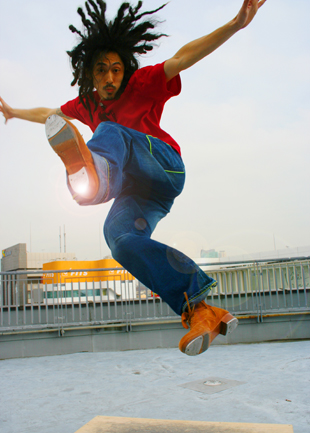
Originally published on metropolis.co.jp on March 2010
As I sit down in a Roppongi Hills interview room with tap dancer Suji Tap, it turns out our paths may have crossed. In my recent visits to Yoyogi Park, I’d noticed groups of tap dancers practicing on the wooden platform next to the pond.
“One of them was probably me,” the affable Suji says with a laugh. “I started going to Yoyogi in my 20s when I needed a place to practice. I made a lot of friends that way.”
Along with Kazunori Kumagai, Suji, 34, has emerged as one of the leading tap dancers of his generation, appearing with the group The Stripes on national TV and in two Takeshi Kitano films (2003’s Zatoichi and 2005’s Takeshis).
“I wouldn’t call it a boom, but there has been a surge in interest since Zatoichi,” he says, noting that most professional tap dancers still have to teach to get by.
Suji (real name Yuji Uragami) came to tap after seeing the 1984 Gregory Hines film Cotton Club. Like many of today’s tappers, he was drawn to the powerful rhythmic style pioneered by African-Americans known as hoofin’, as opposed to the showier Broadway style familiar to the world through the films of Fred Astaire et al. The ease with which hoofin’ could be blended with hip-hop music and breakdancing was part of the appeal for the Kumamoto native.
“I come from a hip-hop background, so it’s a big influence,” he explains. “The question is how to bring hip-hop and tap together in a way that points toward the future of tap.”
Harajuku Beat Street will be Suji’s first big production, and he’s managed to rope together a crew of specialists in breakdancing, BMX bike, freestyle basketball and spoken word poetry who will perform to the accompaniment of a band and DJ. The idea, he says, is to explore the nearly limitless possibilities of Japanese street culture.
“Hip-hop culture and dance forms like tap are not native to Japan, so when we were invited to do this event, I thought about this for a long time,” he says. “Japanese performers can’t hope to replicate the ghetto hunger that made US street culture what it is. In Japan, street culture becomes a product sold for consumption—Japanese are good at selling culture, but it ends up becoming warped. ‘Street’ in its most basic form means living on the streets. But we’re practicing in air conditioned studios—there’s nothing ‘street’ about it at all.”
Instead, Harajuku Beat Street tries to bring to life the experience of wandering through the neighborhood: the sounds of a passing bike, for example, or the sight of a basketball player.
“Instead of aping American street culture, I thought that we should try to do something that captures the Japanese street, bringing to it our own hunger for expression,” he says. “Through this kind of event, we’re trying to shape a uniquely Japanese form of entertainment. But honestly, we don’t quite yet know what that is.”
Harajuku Beat Street
Tap dancer Suji Tap and other performers combine their skills for an all-new production. Mar 27, 3pm; Mar 28, 7pm, ¥3,500 (adv)/¥4,000 (door). Laforet Museum Harajuku. Tel: 0570-02-9999.









